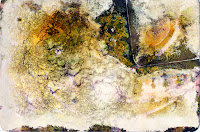Particularly today, the photograph has become synonymous with memory. This connection is overtly used in advertising campaigns. Both the photograph and the memory are parts of a process, and these processes are always ongoing. They both involve the act of seeing: utilising photochemical reactions (on film, photo-sensor, or retina) and an attempt to ‘remember’ using chemicals (print, screen or cortex).
This series of images, which you are now adding to your own memories, grew from an accident. An album of family photographs I had taken in the 1980s was forgotten about and left in the bottom of a box in a damp cellar. Over time, the action of the elements ate into the surface of some of the photographs and ‘destroyed’ the image. Amongst these pictures was the last portrait I had taken of my grandfather, and also a photograph I had won my first competition with.
I liked how the ‘destroyed’ pictures had not remained passive, they had become organic and recorded the effects of their environment. The patterns were quite beautiful. Likewise, our memories are not passive, they are affected by time, age, emotion and environments. So, I experimented with ‘destroying’ other pictures using similar organic, analogue processes. These traditional prints became ‘chemographs’, which, in many ways, is what our memories are.


.jpg)





































No comments:
Post a Comment